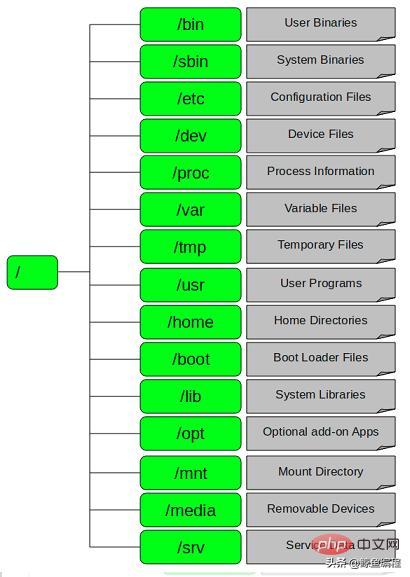What does the boot directory do under centos7?
The boot directory under centos7 is used to store the kernel of the system and the files required to boot the system program; this directory includes the kernel files and files required for booting. In order to avoid insufficient space in the root partition and the inability to start, This directory should be partitioned separately.

The operating environment of this article: centos 7 system, Dell G3 computer.
What is the boot directory under centos7?
/boot The file directory required for the Linux kernel and boot system programs,
such as vmlinuz initrd .img files are located in this directory. Under normal circumstances, the GRUB or LILO system boot manager is also located in this directory.
/boot - Boot loader file, boot directory, including Linux kernel files and files required for booting. It is recommended to partition it separately to avoid insufficient space in the root partition to start.
Contains boot loader Program-related files.
The kernel's initrd, vmlinux, and grub files are located under /boot.
For example:
initrd.img-2.6.32-24-generic、vmlinuz-2.6.32-24-generic
Expand knowledge:

Directory function and meaning
1, /- Root
Every file and directory starts from the root directory.
Only the root user has write permissions in this directory. Please note that /root is the home directory of the root user, which is different from /.
2. /bin - user binary file
contains binary executable files .
In single-user mode, the common Linux commands you need to use are located in this directory. The commands used by all users of the system are located here.
For example: ps, ls, ping, grep, cp
3, /sbin directory - system binary files
Like /bin, / sbin also contains binary executable files.
However, the linux commands in this directory are usually used by system administrators to maintain the system. For example: iptables, reboot, fdisk, ifconfig, swapon command
4, /etc - configuration file
contains the configuration files required by all programs.
Also includes startup and shutdown shell scripts for starting/stopping individual programs. For example: /etc/resolv.conf, /etc/logrotate.conf
5, /dev - device file
contains device files.
These include end devices, USB, or any device connected to the system. For example: /dev/tty1, /dev/usbmon0
6, /proc - Process information
contains information about system processes.
This is a virtual file system that contains information about running processes. For example: information related to a specific pid contained in the /proc/{pid} directory.
This is a virtual file system, and system resources exist in the form of text information. For example: /proc/uptime
7, /var - variable file
var represents the variable file.
Files whose contents may grow can be found in this directory.
This includes - system log files (/var/log); package and database files (/var/lib); email (/var/mail); print queue (/var/spool); lock files (/var/lock);Temporary files required for multiple restarts (/var/tmp);
Recommended tutorial: "centos tutorial"
The above is the detailed content of What does the boot directory do under centos7?. For more information, please follow other related articles on the PHP Chinese website!

Hot AI Tools

Undresser.AI Undress
AI-powered app for creating realistic nude photos

AI Clothes Remover
Online AI tool for removing clothes from photos.

Undress AI Tool
Undress images for free

Clothoff.io
AI clothes remover

Video Face Swap
Swap faces in any video effortlessly with our completely free AI face swap tool!

Hot Article

Hot Tools

Notepad++7.3.1
Easy-to-use and free code editor

SublimeText3 Chinese version
Chinese version, very easy to use

Zend Studio 13.0.1
Powerful PHP integrated development environment

Dreamweaver CS6
Visual web development tools

SublimeText3 Mac version
God-level code editing software (SublimeText3)

Hot Topics
 1392
1392
 52
52
 What are the backup methods for GitLab on CentOS
Apr 14, 2025 pm 05:33 PM
What are the backup methods for GitLab on CentOS
Apr 14, 2025 pm 05:33 PM
Backup and Recovery Policy of GitLab under CentOS System In order to ensure data security and recoverability, GitLab on CentOS provides a variety of backup methods. This article will introduce several common backup methods, configuration parameters and recovery processes in detail to help you establish a complete GitLab backup and recovery strategy. 1. Manual backup Use the gitlab-rakegitlab:backup:create command to execute manual backup. This command backs up key information such as GitLab repository, database, users, user groups, keys, and permissions. The default backup file is stored in the /var/opt/gitlab/backups directory. You can modify /etc/gitlab
 How to optimize CentOS HDFS configuration
Apr 14, 2025 pm 07:15 PM
How to optimize CentOS HDFS configuration
Apr 14, 2025 pm 07:15 PM
Improve HDFS performance on CentOS: A comprehensive optimization guide to optimize HDFS (Hadoop distributed file system) on CentOS requires comprehensive consideration of hardware, system configuration and network settings. This article provides a series of optimization strategies to help you improve HDFS performance. 1. Hardware upgrade and selection resource expansion: Increase the CPU, memory and storage capacity of the server as much as possible. High-performance hardware: adopts high-performance network cards and switches to improve network throughput. 2. System configuration fine-tuning kernel parameter adjustment: Modify /etc/sysctl.conf file to optimize kernel parameters such as TCP connection number, file handle number and memory management. For example, adjust TCP connection status and buffer size
 Centos stops maintenance 2024
Apr 14, 2025 pm 08:39 PM
Centos stops maintenance 2024
Apr 14, 2025 pm 08:39 PM
CentOS will be shut down in 2024 because its upstream distribution, RHEL 8, has been shut down. This shutdown will affect the CentOS 8 system, preventing it from continuing to receive updates. Users should plan for migration, and recommended options include CentOS Stream, AlmaLinux, and Rocky Linux to keep the system safe and stable.
 Centos shutdown command line
Apr 14, 2025 pm 09:12 PM
Centos shutdown command line
Apr 14, 2025 pm 09:12 PM
The CentOS shutdown command is shutdown, and the syntax is shutdown [Options] Time [Information]. Options include: -h Stop the system immediately; -P Turn off the power after shutdown; -r restart; -t Waiting time. Times can be specified as immediate (now), minutes ( minutes), or a specific time (hh:mm). Added information can be displayed in system messages.
 How to check CentOS HDFS configuration
Apr 14, 2025 pm 07:21 PM
How to check CentOS HDFS configuration
Apr 14, 2025 pm 07:21 PM
Complete Guide to Checking HDFS Configuration in CentOS Systems This article will guide you how to effectively check the configuration and running status of HDFS on CentOS systems. The following steps will help you fully understand the setup and operation of HDFS. Verify Hadoop environment variable: First, make sure the Hadoop environment variable is set correctly. In the terminal, execute the following command to verify that Hadoop is installed and configured correctly: hadoopversion Check HDFS configuration file: The core configuration file of HDFS is located in the /etc/hadoop/conf/ directory, where core-site.xml and hdfs-site.xml are crucial. use
 Centos configuration IP address
Apr 14, 2025 pm 09:06 PM
Centos configuration IP address
Apr 14, 2025 pm 09:06 PM
Steps to configure IP address in CentOS: View the current network configuration: ip addr Edit the network configuration file: sudo vi /etc/sysconfig/network-scripts/ifcfg-eth0 Change IP address: Edit IPADDR= Line changes the subnet mask and gateway (optional): Edit NETMASK= and GATEWAY= Lines Restart the network service: sudo systemctl restart network verification IP address: ip addr
 Centos install mysql
Apr 14, 2025 pm 08:09 PM
Centos install mysql
Apr 14, 2025 pm 08:09 PM
Installing MySQL on CentOS involves the following steps: Adding the appropriate MySQL yum source. Execute the yum install mysql-server command to install the MySQL server. Use the mysql_secure_installation command to make security settings, such as setting the root user password. Customize the MySQL configuration file as needed. Tune MySQL parameters and optimize databases for performance.
 What is the CentOS MongoDB backup strategy?
Apr 14, 2025 pm 04:51 PM
What is the CentOS MongoDB backup strategy?
Apr 14, 2025 pm 04:51 PM
Detailed explanation of MongoDB efficient backup strategy under CentOS system This article will introduce in detail the various strategies for implementing MongoDB backup on CentOS system to ensure data security and business continuity. We will cover manual backups, timed backups, automated script backups, and backup methods in Docker container environments, and provide best practices for backup file management. Manual backup: Use the mongodump command to perform manual full backup, for example: mongodump-hlocalhost:27017-u username-p password-d database name-o/backup directory This command will export the data and metadata of the specified database to the specified backup directory.




